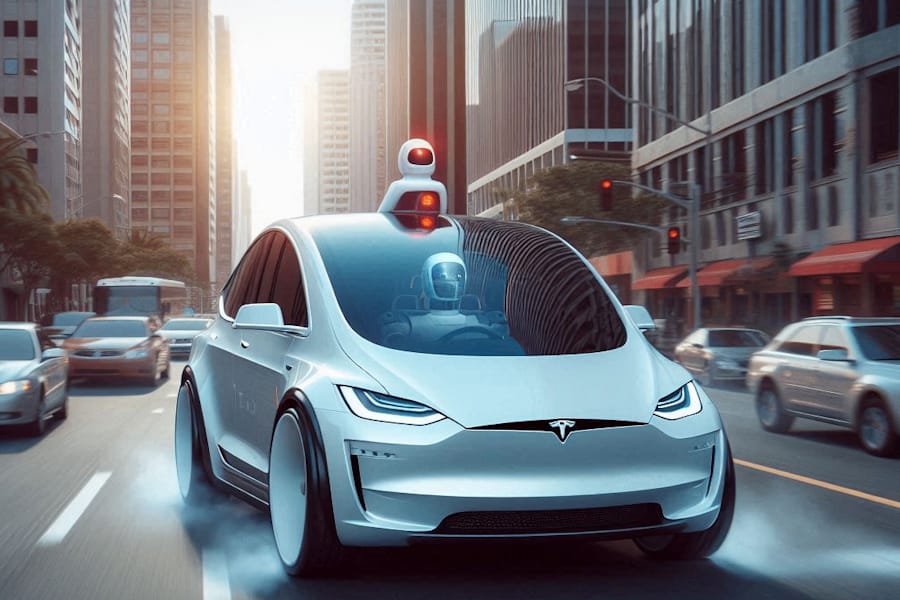Tesla Robotaxi Rollout Faces Scrutiny After Erratic Driving Incidents in Austin

Publish Date: Last Updated: 8th November 2025
Author: nick smith- With the help of GROK3
Austin, Texas, June 30, 2025 – Tesla’s highly anticipated robotaxi service, launched on June 22, 2025, in Austin, Texas, has come under fire following multiple reports of erratic driving behavior. Videos posted on social media by early-access riders, including Tesla influencers and investors, have revealed concerning incidents, prompting an investigation by the National Highway Traffic Safety Administration (NHTSA). The rollout, which involved 10–20 Model Y vehicles equipped with advanced Full Self-Driving (FSD) software, has raised questions about the readiness of Tesla’s autonomous technology and its implications for broader deployment, including potential challenges in markets like the UK.
Incidents Highlight Safety Concerns
The limited trial, restricted to a geofenced area in Austin with safety monitors in the passenger seat, was intended to showcase Tesla’s vision of a driverless future. However, videos captured a range of issues: one robotaxi drove into a lane for oncoming traffic for six seconds before correcting itself, another exceeded the speed limit by 5–10 mph, and others abruptly braked for no apparent reason, such as in response to stationary police vehicles or tree shadows. In a particularly alarming case, a robotaxi dropped passengers off in the middle of a busy six-lane intersection, a move described as “pretty dangerous” by Kara Kockelman, a transportation engineering professor at the University of Texas at Austin.
The NHTSA swiftly contacted Tesla to gather more information, stating, “NHTSA is aware of the referenced incidents and is in contact with the manufacturer to gather additional information.” The agency is already investigating Tesla’s FSD technology following a fatal 2023 crash in Arizona, where a Model Y in FSD mode struck and killed a pedestrian due to issues with sun glare. These incidents add to ongoing concerns about Tesla’s camera-only approach, which lacks the lidar and radar sensors used by competitors like Waymo.
Expert and Public Reactions
Autonomous vehicle experts have expressed alarm at the number of issues observed on the first day. Philip Koopman, a Carnegie Mellon University professor specializing in autonomous technology, noted, “This is awfully early to have a bunch of videos of erratic and poor driving.” He emphasized that the public nature of Tesla’s rollout, with influencers documenting rides, has amplified scrutiny compared to competitors’ more controlled testing phases.
On X, sentiment is mixed. Some users defend Tesla, arguing that early hiccups are expected in new technology, while others criticize the company’s approach, with one post stating, “Tesla’s tech is too immature for prime time—Waymo’s been at this for years and still has issues.” Another user highlighted a video of a robotaxi avoiding a peacock, suggesting potential in the system despite its flaws.
Tesla CEO Elon Musk celebrated the launch as the “culmination of a decade of hard work,” and the company’s stock surged 9.3% on June 23. However, analysts like Bryant Walker Smith from the University of South Carolina caution that Tesla’s ambitious goal of scaling to millions of robotaxis by 2026 is unrealistic, citing repeated delays in Musk’s autonomy promises since 2015.
A Case for a More Gradual Approach
The chaotic debut of Tesla’s robotaxis underscores a broader concern: the rush to deploy autonomous vehicles in complex urban environments may be premature. A safer and more manageable strategy would be to introduce self-driving cars on major roads like motorways, where a dedicated lane for autonomous vehicles could simplify navigation. Motorways offer predictable traffic patterns, fewer pedestrians, and no complex intersections, reducing the variables that challenge current AI systems. Once off these roads, vehicles could revert to manual control, allowing drivers to handle the intricacies of city streets until the technology matures.
This phased approach could build public trust and refine autonomous systems in controlled settings, minimizing risks like those seen in Austin. The current strategy of testing in dense urban areas, where unpredictable scenarios abound, risks serious accidents that could derail the entire robotaxi rollout. A single high-profile crash, especially one involving injuries or fatalities, could halt progress, as seen with General Motors’ Cruise, which shut down after a 2023 pedestrian accident.
Implications for the UK Rollout
The challenges observed in Austin raise significant concerns for the potential rollout of Tesla’s robotaxi service in the UK, where driving conditions and urban layouts present unique obstacles. Unlike the grid-like street patterns of many US cities, UK cities often feature narrow, winding roads, historic cobblestone streets, and complex junctions with roundabouts, which demand precise navigation and quick decision-making. For instance, cities like London, Edinburgh, or Bath have tightly packed streets with frequent pedestrian crossings, cyclists, and double-decker buses, all of which could overwhelm Tesla’s camera-based FSD system, especially given its struggles with glare, shadows, and erratic lane changes in Austin.
The UK’s weather adds another layer of complexity, with frequent rain, fog, and low-visibility conditions that could exacerbate the limitations of Tesla’s vision-only approach. Roundabouts, a staple of UK roads, require nuanced understanding of yield rules and multi-lane dynamics, which autonomous systems have historically found challenging. For example, a 2024 trial of autonomous vehicles in Oxford highlighted difficulties with roundabouts and narrow lanes, even with lidar-equipped systems.
A dedicated motorway lane approach, as proposed, would be particularly advantageous in the UK. Motorways like the M1 or M25 offer controlled environments with fewer variables, allowing Tesla to test and refine its technology before tackling urban complexity. Reverting to manual control in cities would mitigate risks on narrow streets like those in York or Bristol, where a single misjudgment could lead to collisions or pedestrian incidents. The UK’s stringent regulatory framework, overseen by the Department for Transport, would likely demand such a cautious approach, especially after high-profile incidents in the US. A serious accident in the UK could not only stall Tesla’s plans but also prompt stricter regulations, as seen with Uber’s autonomous vehicle testing ban in 2018 after a fatal crash in Arizona.
Public perception in the UK, already skeptical of autonomous vehicles due to safety concerns, could further complicate adoption. A 2025 AA survey found that 65% of UK drivers distrust self-driving cars, citing fears of technology failures. Tesla would need to prioritize transparency and rigorous testing to avoid a backlash that could jeopardize its European expansion.
Looking Ahead
Tesla’s robotaxi service remains in an early phase, with plans to expand to other U.S. cities by year-end and potentially to international markets like the UK thereafter. However, the NHTSA’s ongoing probe and the documented driving issues highlight significant hurdles. Competitors like Waymo, which operates 1,500 robotaxis across multiple cities, have faced similar challenges but benefit from years of testing and additional sensors. Tesla’s reliance on cameras and AI, while cost-effective, struggles with conditions like low visibility, as evidenced by the 2023 Arizona crash.
For the UK, a successful rollout would require addressing the unique challenges of its road network and weather, likely starting with controlled environments like motorways. Without a more cautious strategy, Tesla risks repeating the mistakes seen in Austin, potentially at the cost of public safety and regulatory approval. As Tesla navigates these challenges, the company must balance Musk’s bold vision with the reality of technological and environmental limitations.
Sources: Reuters, The Guardian, Bloomberg, CBS News, TechCrunch, AA Survey 2025
Latest AI News
AI Questions and Answers section for Tesla Robotaxi Rollout Faces Scrutiny After Erratic Driving Incidents in Austin
Welcome to a new feature where you can interact with our AI called Jeannie. You can ask her anything relating to this article. If this feature is available, you should see a small genie lamp above this text. Click on the lamp to start a chat or view the following questions that Jeannie has answered relating to Tesla Robotaxi Rollout Faces Scrutiny After Erratic Driving Incidents in Austin.
Be the first to ask our Jeannie AI a question about this article
Look for the gold latern at the bottom right of your screen and click on it to enable Jeannie AI Chat.






